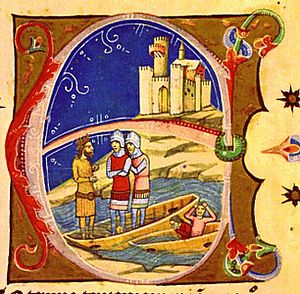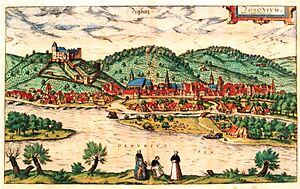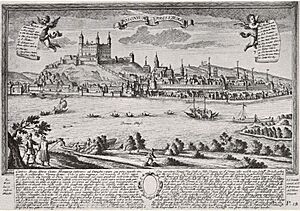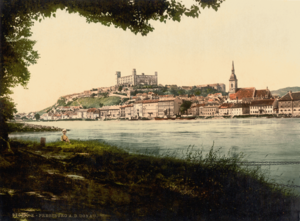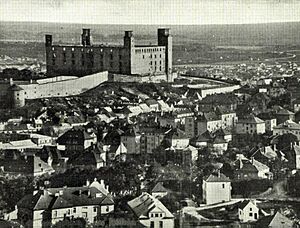History of Bratislava facts for kids
Bratislava (also known as Pozsony in Hungarian and Pressburg in German) is the capital and largest city of Slovakia. It has been around for about a thousand years. Its location near the Danube River made it an important place in Europe. It was a link between the advanced cultures of the Mediterranean and the rest of Europe.
Contents
- Ancient Times
- Roman Times and Slavic Arrivals (1st to 10th Century)
- Growing as a Hungarian Center (1000–1241)
- Challenges and Growth (1241–1536)
- Capital of Royal Hungary (1536–1784)
- A Time of Revival (18th Century)
- Modernization and Revolutions (1784–1900)
- The 20th Century: Big Changes
- Bratislava in the 21st Century
- Who Lived Here: Famous People
- Images for kids
Ancient Times
Long, long ago, even before humans, ancient ape fossils were found in the area of Bratislava. Later, during the Stone Age, early humans lived here. They left behind stone tools. The first known permanent villages appeared during the New Stone Age. A very early fortified settlement, like a small fort, was built where Bratislava Castle stands today. During the Bronze Age, more settlements appeared, especially a strong fort at Devín Castle, overlooking the Morava River where it meets the Danube.
Early Iron Age Settlements
In the early Iron Age, people started settling more in the area of today's city center and Bratislava Castle. This period saw the arrival of Thracian tribes. They brought some Greek-like culture with them. Many old discoveries show that the castle hill and the town area were important centers for the Hallstatt Culture. Rich burial mounds found nearby might have been for important leaders.
Celts and the First City
Around 450 BC to 50 BC, the Celts lived here. A Celtic tribe called the Boii built an important fortified town, called an oppidum, between 125 and 50 BC. This oppidum was located on the castle hill and in the old town center. It even had its own mint, where they made silver coins. These coins often had the word "Biatec" on them. Bratislava became a real town for the first time then! After a big battle, the remaining Celts moved to Devín, a smaller, safer fort.
Roman Times and Slavic Arrivals (1st to 10th Century)
From the 1st to 4th centuries, the Roman Empire's border, called the Limes Romanus, ran along the Danube River. North of the river was "Barbaricum," home to German tribes. South was Roman territory. Near the suburb of Rusovce, you can still find parts of a Roman border town called Gerulata. Even though Bratislava was officially outside the Roman Empire, Romans were present. For example, Devín Castle was once a strong Roman military outpost called Dowina.
The Slavs arrived in this area between the 5th and 6th centuries. This was during a time when many groups of people were moving across Europe. In 568, the Avars, a group from Eurasia, came to the region. After the Slavs successfully rebelled against the Avars, a leader named Samo became king in 623. He created the first known Slavic kingdom, which lasted until 658.
From the 8th century until 907, both the Pressburg fortress and the Dowina (Devín) Castle were important centers of the Principality of Nitra, a Slavic state. The first written mention of Devín Castle (Dowina) was in 864. The first written mention of Bratislava itself (as Brezalauspurc) was in 907. This name likely came from a prince or ruler named Predslav. In 907, the Bavarians were defeated by the Magyars, and Pressburg became part of the growing medieval Hungary.
Growing as a Hungarian Center (1000–1241)
From the year 1000 to the early 1200s, a market town grew below Pozsony Castle (Bratislava Castle). It became a very important place. The castle itself became one of the strongest forts in Hungary. Because of its location, it was often attacked and was a favorite place for Hungarian kings to stay. Around the year 1000, the Pozsony county was founded, one of the first counties in Hungary.
In 1030, the Czech duke Břetislav I attacked Pozsony Castle but was defeated. Twelve years later, he and German troops briefly took the castle. In 1052, the German king Henry III tried to capture Pozsony for two months but failed, though he damaged the castle. The Pope even visited to help make peace!
Later, Hungarian kings like Solomon and Stephen III stayed at Pozsony Castle and made its defenses stronger. Many Hungarians moved to the market town below the castle, joining the Slovaks who already lived there. In 1189, knights going on the Third Crusade to the Holy Land gathered at Pozsony Castle.
Challenges and Growth (1241–1536)
In 1241 and 1242, the Mongols attacked. They couldn't conquer the strong castle and town, but they did destroy the villages around it. After these attacks, the castle was made even stronger. Many German settlers came to the town, and they became the largest group of people there until the late 1800s.
The town was captured several times by the King of Bohemia, Ottakar II, in the 1270s due to conflicts between Hungary and Bohemia. A peace treaty was signed in Pressburg in 1271. The town was also briefly taken by a Hungarian nobleman, Nicolaus von Güssing, who even burned down the castle in 1286. Later, the Austrian duke Albert of Habsburg captured the city, but it eventually returned to Hungary.
In 1291, the Hungarian king Andrew III gave the town its first known special rights, called "town privileges." This made it an official town. Over time, the town received many more privileges from Hungarian kings, especially from Emperor Sigismund in the 1400s. In 1405, Sigismund declared Pressburg a "free royal town." This meant it had special rights, like a noble lord, to help balance the power of other lords in Hungary.
The Hussites, a religious group, attacked the suburbs of Pressburg in 1428. They tried to conquer the city several times but failed. The first bridge over the Danube in Pressburg was built in 1434, but it was destroyed by floods the next year.
From 1465 to 1490, Pozsony was home to the first university in present-day Slovakia, called the Universitas Istropolitana. After the Battle of Mohács in 1526, where the Kingdom of Hungary was defeated by the Turks, the Turks tried to capture Pressburg in 1529 but failed. The city became a safe place for the Holy Crown of Hungary, keeping it safe from both the Turks and the Habsburgs.
Capital of Royal Hungary (1536–1784)
Because the Ottoman Turks advanced into Hungary and captured Buda, Pressburg was chosen as the new capital of Royal Hungary in 1536. Royal Hungary was part of the Habsburg Monarchy from 1526 to 1918. Pressburg also became the meeting place for the Hungarian Parliament (called the Hungarian Diet) from 1542 to 1848. It was also the city where Hungarian kings and queens were crowned, from 1536 to 1830, in St. Martin's Cathedral. A total of 11 kings and 8 queens were crowned here. During the reign of Queen Maria Theresa of Austria, Bratislava grew a lot economically and socially.
However, in the 1600s, the town faced many problems. There were uprisings against the Habsburg rulers, battles with the Turks, floods, and terrible diseases like the plague. The Evangelic Lutheran Lyceum, an important Protestant school, was founded in 1607.
Uprisings and Challenges
Several anti-Habsburg uprisings affected Pressburg. In 1619, Gabriel Bethlen conquered Pressburg, but he was later defeated. A peace treaty was signed in 1626. From 1671 to 1677, special courts were held in Pressburg against Protestants and those who joined the uprisings. In the Imre Thököly Uprising (1682–1683), Pressburg was the only town in Slovakia that refused to surrender to Thököly's troops. The town eventually gave in, but it was taken back by Imperial troops after the Turks were defeated near Vienna. The last major uprising that affected the town was in 1704, during the Rákóczi Uprising.
A Time of Revival (18th Century)
Since the 1700s, Bratislava has been a key center for the Slovak national and cultural movement. A terrible plague epidemic killed 3,800 people in 1710 and 1711. Later, the Holy Trinity column was built to thank God for its end.
In the 18th century, many beautiful new baroque buildings were constructed. The economy grew, with the first factory opening in 1728. The first parks were also created. In 1775, the old town walls were torn down to allow the city to expand. The first city theater opened in 1776. Pressburg became the largest and most important town in the region. The first newspaper in Hungary was published here in 1705.
In 1741, Maria Theresa of Austria was crowned Queen of Hungary at St. Martin's Cathedral. In 1762, a young Wolfgang Amadeus Mozart, who was only 6 years old, gave a concert in the Pálffy Palace. The first German newspaper in Hungary started in 1764, and the first Hungarian newspaper in 1780.
The city's population grew a lot, reaching 33,000 by 1782, making Pressburg the largest town in Hungary. In 1783, the first newspaper in Slovak was published, along with the first novel in Slovak. In 1775, Coronation Hill was built. New monarchs would ride to this hill and wave their sword in four directions.
However, in 1783, under Emperor Joseph II, the Crown Jewels were moved to Vienna. Many government offices also moved to Buda. This caused the population to decrease and the city's economy to suffer until 1811.
Modernization and Revolutions (1784–1900)
From 1784 to 1800, a school for Catholic priests, the General Seminary, was located in Pressburg Castle. One of its famous students was Anton Bernolák, who created the first standard for the Slovak language in 1787.
Pressburg also played a role in European politics. In 1805, the important Treaty of Pressburg was signed here by Austria and France after Napoleon I's victory. Four years later, Napoleon's army attacked the city. Devín Castle was destroyed by French troops in 1809, and Pressburg Castle was accidentally burned down in 1811, remaining in ruins until the 1950s.
In 1820, the 9-year-old Franz Liszt, a famous composer, played in a palace here. In 1825, István Széchenyi helped establish the Hungarian Academy of Sciences in Pozsony. In 1829, students at the Lutheran Lyceum created a society that became important for the Slovak national movement. Ľudovít Štúr, a key figure in Slovak history, studied and taught there for 20 years. In 1843, he created the modern Slovak language standard.
The city began to industrialize in 1830 with regular steamship transport on the Danube. In 1840, the first horse-drawn railway line in Hungary and Slovakia was built from Pressburg to Svätý Jur.
- 1835: The first champagne in Hungary was made in Pressburg.
- 1843–1844: The Hungarian language was declared the official language in government and education by the Parliament.
- 1848: Emperor Ferdinand I of Austria signed the "March Laws" in the Primate's Palace. These laws partly ended serfdom in Hungary. This was the last Hungarian Parliament held in Pressburg, as it then moved to Budapest.
- 1848–1849: During the 1848 Revolution, the Hungarian National Guard was formed in the city. A railway connection to Vienna was established in 1848, and to Budapest in 1850.
- Late 19th century: Pressburg saw a period of great growth and modernization. New sewers and gas works were built in 1856. Telephone and electrical lighting systems started in 1884. A new water supply system was built. The first permanent bridge over the Danube, Starý most, opened in 1891. A tram system started in 1895, and public electricity in 1902. The city also became industrialized, with chemical and oil factories opening. By the end of the Austro-Hungarian monarchy, Pressburg was the second most industrialized town in Hungary.
- 1866: The Battle of Lamač took place in Pressburg, the last battle of the Austro-Prussian War.
- 1886: The city theater (now the Slovak National Theatre) opened.
- 1897: A statue of Maria Theresa was put up on Coronation Hill square.
The 20th Century: Big Changes
After World War I, the Austro-Hungarian Empire broke apart. The United States played a big role in creating the new country of Czechoslovakia. Some American Slovaks even suggested renaming the city "Wilson City" after U.S. President Woodrow Wilson.
On October 28, 1918, Czechoslovakia was declared. The Hungarian and German people in the city tried to keep it from joining Czechoslovakia. However, on January 1, 1919, Czechoslovak troops entered Bratislava. By January 2, they controlled all important buildings. The city became the capital of Slovakia on February 4.
On February 12, 1919, there was a protest where Czechoslovak soldiers fired on demonstrators, causing deaths and injuries. On March 27, the city's official new name became "Bratislava."
On May 4, Milan Rastislav Štefánik, a French-Slovak general and one of Czechoslovakia's founders, died in a plane crash near Bratislava. In 1921, the statue of Maria Theresa was destroyed by Slovak nationalists.
By 1930, the Hungarian population in the city had decreased. Between 1938 and 1939, Bratislava became the seat of government for autonomous Slovakia within Czechoslovakia. From 1939, after Czechoslovakia broke up, Bratislava became the capital of the First Slovak Republic. By 1945, most of the city's Jewish population had been sent to concentration camps. The Soviet Red Army took Bratislava on April 4, 1945.
After World War II
After the war, most of the German population were expelled. In 1946, Jews in the city were attacked during riots.
In 1946, Bratislava grew by adding nearby villages like Devín and Petržalka. In 1947, more villages were added from Hungary to give Bratislava space to grow. After the Communists took power in 1948, Bratislava became part of the Eastern Bloc. Many cultural institutions were founded, like the Slovak Philharmonic Orchestra (1949) and the Slovak National Gallery (1951). New landmarks were built, including the reconstruction of Bratislava Castle (1953–62) and the Nový Most, a new bridge over the Danube (1972).
The city was also affected by the Prague Spring in 1968, an attempt to make the Communist government more open. Shortly after, Bratislava became the capital of the Slovak Socialist Republic, part of a federalized Czechoslovakia. From the 1960s, many large apartment buildings were constructed. The city expanded again in 1972, adding more villages. The third bridge over the Danube, Prístavný most, was built in 1985. The fall of Communism was hinted at by the candle demonstration in 1988, which police broke up.
After Communism Fell
In November 1989, Bratislava was a key center of the Velvet Revolution. This was a peaceful movement that ended Communist rule. Alexander Dubček, a famous Slovak politician, gave a speech in the city. Students rallied against the Communist government. The first non-Communist political party was formed on November 21.
In 1991, the Volkswagen car factory was founded in Bratislava. The fourth bridge over the Danube, Most Lafranconi, was built. On July 17, 1992, the Slovak National Council adopted the Declaration of Independence of the Slovak Nation. Six days later, the leaders of Czechoslovakia agreed to split the country into two independent states. The Constitution of Slovakia was adopted on September 1 and signed at Bratislava Castle on September 3. After Czechoslovakia officially dissolved in 1992, Bratislava became the capital of independent Slovakia.
Bratislava in the 21st Century
| Year | What Happened |
|---|---|
| 2003 | The millionth car was made at the Volkswagen factory in Bratislava. |
| 2003 | Construction started on the fifth bridge over the Danube, the Apollo bridge (Most Apollo). It opened in 2005. |
| 2005 | U.S. President George W. Bush and Russian President Vladimir Putin met in Bratislava for a summit. |
| 2010 | A statue of Svatopluk I of Moravia, a 9th-century leader, was unveiled at Bratislava Castle. |
Who Lived Here: Famous People
Many important people were born, lived, or visited Bratislava throughout its history. Here are a few:
- Ján Bahýľ (1866–1916): A Slovak inventor who worked on flying machines.
- Anton Bernolák (1762–1813): He created the first standard for the Slovak language.
- Napoleon Bonaparte: The famous French leader visited Bratislava.
- Matthias Corvinus (1443–1490): A Hungarian king who founded the Universitas Istropolitana, the first university in Slovakia.
- Alexander Dubček (1921–1992): A Slovak politician who lived in Bratislava.
- Johann Nepomuk Hummel (1778–1837): A composer and pianist born in Pressburg.
- Wolfgang von Kempelen (1734–1804): An inventor born in Pozsony.
- Philipp Lenard (1862–1949): A physicist who won the Nobel Prize in 1905, born and raised in Pressburg.
- Imi Lichtenfeld (1910–1998): The founder of the martial art Krav Maga, who grew up in Bratislava.
- Franz Liszt (1811–1886): A Hungarian composer who played many concerts in Pozsony.
- Sigismund of Luxemburg (1368–1437): A Holy Roman Emperor who gave many important rights to the town and had the castle rebuilt.
- Wolfgang Amadeus Mozart (1756–1791): The famous composer gave his only concert in Hungary in Pressburg.
- Sándor Petőfi (1823–1849): An important Hungarian poet who often visited Pozsony.
- Ľudovít Štúr (1815–1856): One of the most famous figures in modern Slovak history. He led the Slovak national movement and created the modern Slovak language standard. He spent 20 years at the Evangelic Lutheran Lyceum.
- Maria Theresa of Austria (1717–1780): The Archduchess of Austria and Queen of Hungary. She spent a lot of time at Pressburg Castle and had it restored.
- Milan Rastislav Štefánik (1880–1919): A very important figure in modern Slovak history, an astronomer and French army general. He helped create Czechoslovakia and died near Bratislava. The Bratislava Airport is named after him.
Images for kids


